BecomeSingers is reader-supported. When you buy through links on our site, we may earn an affiliate commission. Learn More
Are you looking for a high-quality microphone to record vocals, play video games, or maybe even just for your Zoom calls but worried that you might not have the budget for one? Well, we’re happy to tell you that you do! We have curated a list of 7 of the best condenser and USB mics under $50 that will perform incredibly well and save you thousands of dollars for you to invest elsewhere.

Buying a new microphone can be a complex experience. Especially if you’re on a budget and unfamiliar with the technicalities of a mic but still want great value for your money and be satisfied with your choice once you’ve purchased and tested the microphone. There are a few factors to consider before making your decision. The most crucial factor is the reason for your purchase. Do you need it for recording vocals? Instruments? Do you want to use it for your new podcast? Every microphone has its unique set of features, and we’re here to help you decipher them and help you make your decision.
Also Read: 15 Best ASMR Microphones
Table of Contents
Best Microphones under $50 – Comparison table
| Product Image | Product Name | Power | Polar Patterns | Connectivity | Frequency Response |
| Shure SM48 | 12V | Cardioid | XLR | 55Hz – 14kHz | |
| Behringer Ultravoice XM8500 | 12V | Cardioid | Gold-Plated XLR | 50 Hz – 15 kHz | |
| Shure PGA48 | 12V | Cardioid | XLR | 70Hz – 15kHz | |
| Peavey PVi 2 | 12V | Cardioid Unidirectional | XLR | 50Hz – 16kHz | |
| Fifine K669 | 5V | Cardioid | USB | 20Hz – 20kHz | |
| Blue Snowball iCE | 240V | Cardioid | USB | 40Hz – 18kHz | |
| Samson Go Mic | 5V | Cardioid or Omnidirectional | USB | 20Hz – 18kHz |
7 Best Microphones under $50
1. Shure SM48
The SM48 is known as SM58’S younger sibling. Both are ruggedly built and intended for vocal use due to their wide frequency response. The SM48 is an excellent microphone for backup vocals, live performances, broadcasting applications, and studio recordings.
The microphone will deliver excellent results thanks to its crystal clear sound, a shock-mounted capsule that dramatically reduces handling noise, a built-in pop filter that helps block the popping sound associated with air gusts from sources like a human voice, and superior build quality that Shure is known for. Once you start using the microphone, you won’t feel like you just spent less than $50 on a budget microphone. The SM48 will not disappoint and offer you great value for your money.
Features:
- Built-in “pop” filter.
- Lockable On/Off switch.
- Superior built quality.
- Shock-mounted cartridge.
- Frequency response tailored for vocals.
- Superior gain before feedback.
- No off-axis sound.
Pros:
- Excellent sound.
- Rugged build.
- Wide frequency range.
Cons:
- Less rich sound than more expensive microphones.
- Limited functions.
2. Behringer Ultravoice XM8500
If you’re looking for a budget microphone that’s known for its unbeatable build (literally), it’s the Behringer Ultravoice Xm8500. It is one of the most robust budget microphones that feels significant when you carry it, which will save you a little worry if you accidentally drop it and think it’s forever gone.
Audio-wise, the Behringer XM8500 offers a loud yet warm sound that’s primarily excellent for recording instruments. It contains an internal shock mount that controls disturbances and an explicit suspension for noise reduction. Any mechanical noise, vibrations, and air disturbance are reduced through a two-step pop channel. With this mic, you obtain a clear recording of your voice or instrument while still being on a less than $50 budget.
Features:
- Ultra-wide frequency response.
- Minimal background noise and feedback.
- Integrated spherical wind and pop noise filter.
- Excellent voice projection.
- Extremely high signal output.
- Shock mount system to cut down handling noise.
- Microphone stand adapter and impact-resistant carrying case included.
Pros:
- Rugged build.
- Excellent noise reduction.
- Warm sound.
Cons:
- Does a better job recording instruments than it does vocals.
Also Read: 15 Best Microphones For Recording
3. Shure PGA48
The PGA48 is a phenomenal microphone considering the small price tag that comes with it. It is one of the most basic microphones that will surely surprise you with its crystal-clear sound and highly durable design. It’s perfect for karaoke, rehearsals, and even sampling your vocals to your DAW. It’s nicely built, cost-effective, delivers minimal feedback, and overall a tremendous entry-level handheld mic to consider if you’re on a budget. The PGA48 is a fantastic microphone for average daily use. Still, it will exceed your expectations with its excellent dynamic range and clear sound.
Features:
- On/Off switch.
- No unwanted noise and minimal feedback.
- Slick design with black metallic finish and grille featuring classic silver ball grille.
- Clarity in the standard frequency range of speech.
Pros:
- Good value for money.
- Nicely built.
- Offers clear sound.
▪ Great entry-level microphone for basic use.
Cons:
- Might pick up handling noise.
- Clear but average sound.
- Doesn’t perform well on high volumes.
Visit this buying guide for the best microphones for recording vocals on computer.
4. Peavey PVi 2
Often compared to the more expensive Shure SM58, the Peavey PVi 2 offers similar characteristics to the SM58 at half the price! This microphone records both vocals and instruments perfectly, providing a genuine, clear sound with no distortion. It has a sleek, well-built design and comes with a complimentary 20-ft XLR-m to XLR-f cable that other mics don’t appear to provide. If you need a cheap microphone to do it all, this convenient microphone will come to your rescue. We highly recommend it.
Features:
- On/Off switch.
- High quality, clean sound reproduction.
- Low pop and handling noise.
- Rugged build.
- Low-gloss black finish.
- Cardioid unidirectional polar response.
Pros:
- Sleek design.
- High-quality sound.
- Solidly built.
Cons:
- Not a great microphone for DJs.
- Might pick up handling noise.
5. Fifine K669
With a wide frequency response of 20Hz – 20kHz, the Fifine K669 makes a great portable microphone for voiceovers and live-streamers. It offers a clear sound on both the high-end and mids but might lack on the bass or low-end side of the spectrum. So, recording vocals or live instruments in a professional environment might not be in the Fifine K669’s job description. However, it is an excellent mic for podcasts and any real-time audio recording and will perform perfectly if this is your purpose.
Features:
- Customized unidirectional capsule and a single knob for volume control.
- Rugged build with an all-metal body.
- Wide and flat frequency response.
- Impressive sound focusing and picking up details.
- A vertical and horizontal adjustable pivot mount.
Pros:
- Compact and travel-friendly design.
- Solidly built.
- Good value for money.
- Perfect for podcasts, live-streamers, and voiceovers.
Cons:
- Lack of mic-monitoring.
- Not great for recording singing vocals or instruments.
Also Read: How to Connect XLR Mic to Computer
6. Blue Snowball iCE
The Blue Snowball iCE is one of the best USB microphones under $50 on the market today. It’s known for its unique retro design. It’s compact and travel-friendly, making it perfect to use anywhere you desire. It’s a great level-entry microphone for Youtubers and live-streamers as long as you buy a pop filter to avoid those annoying breathing and popping sounds. The Blue Snowball iCE is not the mic for you if you’re looking to record your vocals for a track or live instruments, as the sound will most likely come out distorted and unclear. It is, however, an excellent choice if you’re looking for a budget USB microphone to sit on your desk while you use it to play online video games with your friends or record a new podcast.
Features:
- High-quality and crystal-clear sound.
- Works with any software on any computer.
- Plug and play.
- Available in white and black.
Pros:
- Great design.
- Portable.
- Perfect for live-streamers.
- Plug and play ready.
Cons:
- You have to get close to the mic for better results.
- No pop filter included.
Visit our article on the best Room Microphones by Become Singers.
7. Samson Go Mic
The Samson Go Mic is the definition of “an oldie but a goodie.” This portable condenser microphone made our list even though it’s more than 15 years old.
While it doesn’t have studio-quality audio, the Samson Go Mic is the perfect choice for recording interviews, podcasts, voiceovers, and other live audio recordings. Its compact and simple design allows you to use it in any environment. Whether it’s inside your bedroom for your live streams or outside conducting interviews, the Samson Go Mic will perform exceptionally well. (Just be careful there isn’t too much ambient noise.) It also comes with a very sturdy steel stand and a case in case you’re planning to travel with it.
Features:
- Includes two microphone pickup patterns, cardioid (unidirectional) and omnidirectional.
- Plug and play.
- Zero latency when recording audio.
- Foldable and compact design.
Pros:
- Portable and lightweight.
- Does not need phantom power to operate.
- Both cardioid and omnidirectional patterns are available.
- Plug and play ready.
Cons:
- No pop filter included.
- Might pick up handling noise.
Also Read: Optimal Blue Snowball Mic Settings
Things to consider before buying a microphone under $50 (Buyer’s guide):
Before making a rash decision and buying the first microphone you see just because it looks cool or simply fits your budget, there are a few things to consider to get the best out of your new microphone. We’ll start with:
Polar Patterns
The polar pattern of a microphone indicates the direction in which a microphone will be sensitive to picking up sound. A cardioid polar pattern means that the mic will pick up sound in the exact opposite direction, while an omnidirectional polar pattern picks up sounds from all directions. There are more than nine microphone polar patterns, including cardioid, omnidirectional, bidirectional, supercardioid, etc.
We’re explaining only those two polar patterns because most microphones under $50 will have a cardioid polar pattern, which is the most basic and common pattern found in microphones. When choosing your microphone, you might think that a cardioid is the right choice, but quite often, an omnidirectional would perform better.
Transducer Type
There are two primary transducer types. Dynamic and Condenser.
Before choosing the right microphone, you must consider what you want to record and your setting. Dynamic microphones are favorable if you’re not looking for accurate sound reproduction, as their high and low-end frequency response is average. So if you want a microphone for conducting interviews, live-streaming, gaming, or just general voice recordings, a dynamic microphone is the way to go.
On the other hand, a condenser microphone does a better job of picking up frequencies from all the frequency spectrum. It will reproduce better bass and treble than a dynamic microphone, making it better for studio recordings and professional environments. It is, however, more sensitive and less durable than a dynamic microphone and won’t handle heat and humidity as well as a dynamic microphone. So, choose wisely!

Placement and Position
Every proper mic placement has its own “sweet spot” where a source sounds its best.
To help you find that sweet spot, you must first consider the microphone’s polar pattern (cardioid or omnidirectional, etc.). Each polar pattern requires its set of directions to follow to help you reach that sweet spot. The polar pattern will also determine the distance between the sound source and the microphone, as well as the position of the microphone. The ambiance or room is another critical factor to consider before placing your microphone.
Proper mic placement is a complicated topic as there are dozens of things to go through before positioning your mic. But the best thing you can do is experiment with your microphone placement and position and give it some time. You will eventually find that sweet spot, especially in a simple setting. Suppose you are in a more complicated recording environment. In that case, it’s best to reach out to a sound engineer as it is their job to perfectly place microphones for optimal results.
Connection Type
There are a few microphone connection types on the market like XLR, Mini XLR, USB, etc., but the most common are XLR and USB.
Both have their advantages and disadvantages. XLR microphones tend to have higher sound quality than USB but are more expensive than USB mics. USB microphones are known for their simplicity and “plug and play” factor but have fewer options on the market than XLR microphones. XLR mics are suitable for recording a few people simultaneously, but USB microphones require no extra gear like an interface to record.
It all depends on the purpose of your purchase. But if you have the budget, then you should definitely invest in an XLR microphone and develop your professional setup over time.
Frequency range
The average human can hear sounds ranging from 20 to 20,000 Hz. And many microphones have a frequency response that falls within that same range. However, depending on the microphone type, some cut out at very low frequencies to avoid unwanted noise and rumble (-100Hz), and some cut out at very high frequencies (+10kHz) to reduce unnecessary noise. When choosing microphones for specific applications, the low and high ends of the frequency response are crucial considerations.
Different microphones have different frequency “bumps” at specific frequency ranges for accurate sound reproduction of your instrument or source. These bumps vary for each microphone depending on the type and purpose of that microphone. Additionally, it would be best if you always chose a mic with a frequency that enhances the sound of the source while considering your recording environment.

Materials
Mylar plastic (polyester film) is typically used as the diaphragm material in professional microphones. The housing for the cartridge is often composed of non-conductive materials like hard plastic and non-magnetic metals. Stainless steel or robust non-magnetic steel is frequently used for the body/case material, and the lead wires are insulated copper strands.
There are also more materials used in a microphone, but these are the most critical parts/factors to consider and look for in a microphone.
FAQ
What is the perfect way to clean cheap mics?
You can clean both dynamic and condenser microphones using the same method.
Start by carefully unscrewing or removing the microphone's grille. Then wipe it using a solution of lukewarm water and a mild detergent such as dishwashing liquid and a soft cloth. Gently rub the grille with a toothbrush to remove the dirt. You can also use a gentle disinfectant if any residue is left even after using the dishwashing liquid. Finally, let the freshly cleaned grille air dry without getting a drop of water in your microphone as it can damage it.
What is the best budget gaming mic?
One of the best gaming mics in the market today is one we mentioned earlier on our list—the Blue Snowball iCE.
This plug-and-play USB microphone has a cardioid pattern for crystal-clear audio, a retro look, and a very compact design that lets you travel with it wherever you please. Our only recommendation for this microphone is that you buy yourself a pop filter that helps get rid of unwanted popping and noise.
What is the highest quality USB mic?
A few high-quality USB microphones will deliver exceptional sound quality and clarity and optimize your setup. However, the mic that easily takes the crown today is the HyperX QuadCast condenser microphone.
This beast has four polar patterns you can choose from; Cardioid, omnidirectional, bidirectional, and stereo. Gain control that lets you adjust your mic’s sensitivity. A simple mute button to tap on the top of the microphone, just in case your mom or wife comes in your room to lecture you while you’re gaming with your friends. An anti-vibration mount that isolates the mic and suppresses the sound of rumbles. A built-in pop filter that reduces any muffles or popping noises. LED indicators. And a mount adapter that fits both 3/8” and 5/8” thread sizes that is compatible with most microphone stands.
We highly recommend this microphone not only for its excellent performance but for its stunning aesthetic and versatility too.
Visit Become Singer‘s article if you want to connect multiple mics .
Conclusion
Just because you’re on a budget doesn’t mean you can’t get a premium microphone that will perform to your high standards. There are many different brands and options available, whether it’s a dynamic or condenser mic. A USB or XLR mic. A cardioid or omnidirectional mic. Hopefully, we made your decision-making process a little easier by giving you what we think are some of the best microphones under $50 in the audio and recording world.
All you have to do is carefully review our selection, choose the item that best meets your needs, and finally make that purchase! We guarantee that none of our picks will disappoint you and that all offer exceptional sound!












